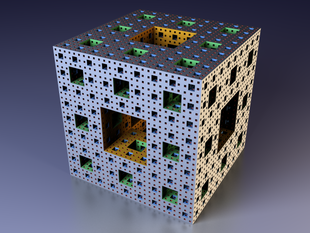
Back إسفنج مينغر Arabic Губка Менгера Byelorussian Esponja de Menger Catalan Mengerova houba Czech Mengers svamp Danish Menger-Schwamm German Σπόγγος του Μένγκερ Greek Spongo de Menger Esperanto Esponja de Menger Spanish اسفنج منگر Persian

In mathematics, the Menger sponge (also known as the Menger cube, Menger universal curve, Sierpinski cube, or Sierpinski sponge)[1][2][3] is a fractal curve. It is a three-dimensional generalization of the one-dimensional Cantor set and two-dimensional Sierpinski carpet. It was first described by Karl Menger in 1926, in his studies of the concept of topological dimension.[4][5]
- ^ Beck, Christian; Schögl, Friedrich (1995). Thermodynamics of Chaotic Systems: An Introduction. Cambridge University Press. p. 97. ISBN 9780521484510.
- ^ Bunde, Armin; Havlin, Shlomo (2013). Fractals in Science. Springer. p. 7. ISBN 9783642779534.
- ^ Menger, Karl (2013). Reminiscences of the Vienna Circle and the Mathematical Colloquium. Springer Science & Business Media. p. 11. ISBN 9789401111027.
- ^ Menger, Karl (1928), Dimensionstheorie, B.G Teubner Publishers
- ^ Menger, Karl (1926), "Allgemeine Räume und Cartesische Räume. I.", Communications to the Amsterdam Academy of Sciences. English translation reprinted in Edgar, Gerald A., ed. (2004), Classics on fractals, Studies in Nonlinearity, Westview Press. Advanced Book Program, Boulder, CO, ISBN 978-0-8133-4153-8, MR 2049443
© MMXXIII Rich X Search. We shall prevail. All rights reserved. Rich X Search